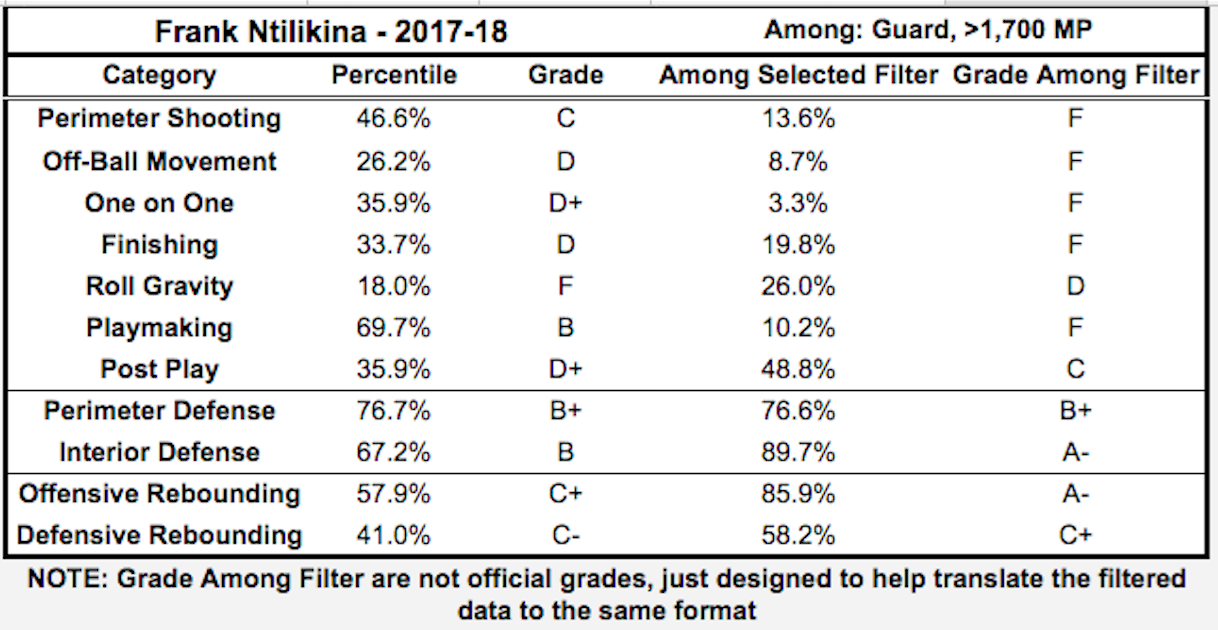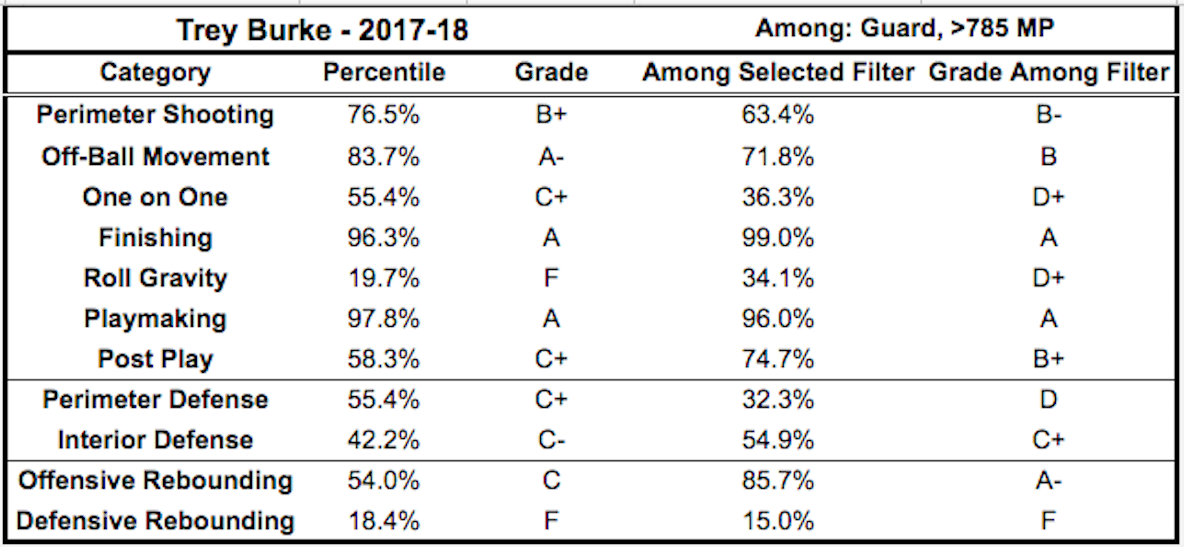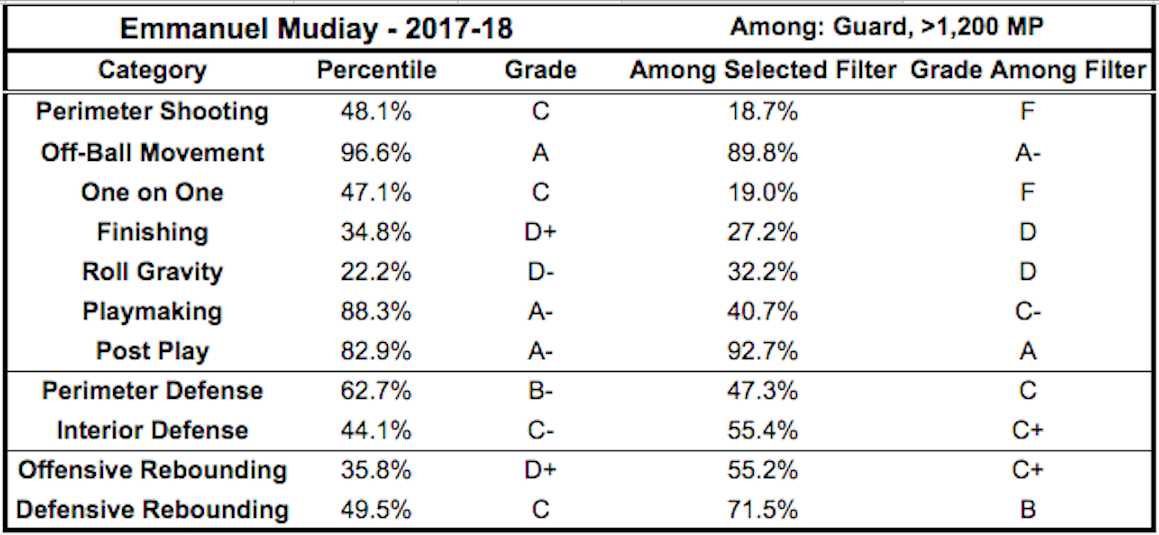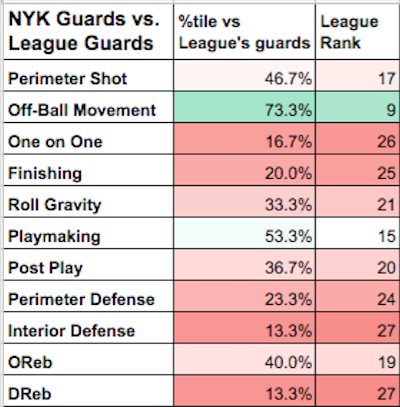
Answering the Knicks’ Point Guard Questions
The Knicks head into the 2018-19 season with questions at nearly every level: When will we see a 100% healthy Kristaps Porzingis? How will David Fizdale fare in his second head coaching stint? Will newcomers Kevin Knox and Mitchell Robinson inspire hope of being future franchise cornerstones? The most intriguing on-court question (outside the rookies) will be how Fizdale manages his point guard rotation between Frank Ntilikina, Trey Burke, and Emmanuel Mudiay. To better understand their strengths and weaknesses, as well as how they should be used, let’s look at each of the Knicks’ point guards.
Frank Ntilikina
This time last year, Frank was looking at a new job, new teammates, new city and new country, while trying to learn the most difficult position in the world’s premier basketball league. His discomfort showed on the offensive end. Per BBall Index’s proprietary stats, since 2015-16, there have been 242 instances of guards playing at least 1700 minutes in a season (the same number as Frank’s rookie campaign). Among that large sample size, Frank ranked in the bottom 20% in perimeter shooting, off-ball movement, one on one play, finishing, and playmaking. See below for an entire breakdown of Frank’s game compared to the league at large since 2015 (left side of chart) and that aforementioned sample of guards (right side).

The area in which Frank most desperately needs to make strides is playmaking, where he ranked in just the 10th percentile among qualifying guards in 2017-18. A major reason for his struggles was his poor production as a pick-and-roll ball handler, which accounted for 40% of his used possessions. Per NBA.com, 59 players initiated at least 250 pick-and-rolls, and among that group, Ntilikina ranked dead last in points per possession at 0.67. Turnovers were a primary reason for his inefficiency, coughing it up on 19.7% of his pick-and-rolls, 8th highest among that group of 59 ball handlers.
If Frank wants to project as the lead initiator on offense, he’ll need to be more aggressive and turn the ball over less – a tough combination. If he becomes more of a scoring threat himself, that should help open things up for teammates. This season look for his touch around the rim to improve.
Some Knicks fans may argue that it’s OK if Frank never develops into a primary ball handler. His ability to defend the opponent’s best perimeter player, regardless of position, takes a huge burden off of his backcourt mates, and gives the Knicks some lineup flexibility. For example, Trey Burke’s offensive skill set is a must-have for the Kristap-less Knicks, but his lack of size makes him difficult to hide on D. The point guard position is too loaded for Burke to be expected to carry the offense and chase his man through dozens of pick-and-rolls every game. That’s where Ntilikina comes in, allowing Burke to hide on the Michael Kidd-Gilchrists of the world.
For him to be a viable off-ball option, Frank would need to improve his perimeter shooting, where, as I mentioned, he graded out to an F among qualifying guards last season, per BBall Index stats. He did show some flashes of promise, though. On his 97 catch-and-shoot three-point attempts, he connected on a respectable 36.1%. Early this season, I will perform a deep dive into Frank’s shooting with the help of our resident shot form expert, Dylan Ward.
Trey Burke
Trey Burke debuted for the Knicks on January 15th and only played 36 total games on the season, but he made his presence felt. Immediately, he was the most dynamic off-the-dribble creator, both scoring for himself and setting up teammates. Per The BBall Index database, there have been 419 player seasons since 2015 in which guards played as many minutes as Burke (785 mins); of that enormous group, he ranked in the 99th percentile in finishing at the rim and the 96th percentile in playmaking. Burke also finished as the second-best mid-range shooter in the NBA, just barely behind Chris Paul. Obviously, those numbers are not likely to sustain for an entire season, but they are indicative of Burke’s strengths and offensive upside.

In many ways, he’s the Anti-Frank. He used over 42% of his possessions as a pick-and-roll ball handler and finished in the 87th percentile in efficiency, converting 0.98 points per possession. He scored inordinately high on pull-up mid-range jumpers, but he also showed incredible craft around the basket for a player his size. In the following montage, Burke 1) rejects a screen and drives down hill for the contested layup, 2) embarrasses Jabari Parker on a switch, 3) rejects another screen and finishes in traffic, and 4) splits Draymond Green and Klay Thompson to get an uncontested layup.
Arguably even more impressive than his scoring was Burke’s playmaking. In the plays below, Burke shows his ability to create out of the pick-and-roll through a combination of snaking screens, forcing bigs to commit, and finding cutters.
Burke’s defense and size are what limit his chances of becoming a two-way impact player. A couple players his stature come to mind for their defense – Kyle Lowry and Chris Paul – but both guys are built differently. Their strong lower bodies (coupled with their next-level competitiveness and defensive instincts) give them leverage to defend players much larger. Trey will likely always need to be hidden on the other team’s worst offensive guard, which makes him a tricky fit in some backcourt combinations.
Emmanuel Mudiay
If Trey Burke’s redemption story in New York has taught Knicks fans anything, it’s not to give up on 22-year-old point guards who struggle to adjust to NBA gameplay in their first few seasons. With that said, Mudiay makes it tough sometimes. His weaknesses are a running list of what you want in a modern point guard: perimeter shooting, perimeter defense, finishing, one-on-one skills. The table below shows how Mudiay grades out, first against the entirety of the league (left side of chart), and then how he stacks up against other guards who played similar minutes:

Those stats don’t even look as bad as they felt towards the end of last season. Granted, I only watched Mudiay’s 22 games in a Knicks uniform, during which he was abysmal. He averaged 9 points on 37/20/69 shooting splits. He was in the 16th percentile as a pick-and-roll ball handler, and worst of all, there were long stretches where he looked disinterested in playing defense. Fizdale should give Mudiay some regular minutes to start the season, but if his effort and production do not improve, I’d be comfortable relegating him to a garbage time role.
The tension between Fizdale developing players while also wanting to prove he can coach winning basketball will be something to watch all season. In years past, Porzingis has started the season hot, giving Knicks fans fantastical visions of an eight-seed, before coming back to reality. This season will look bleak from day one. There will be no illusions. But there is potential for this young crop of point guards to impress.
The BBall Index has projected total minutes per game for this season and they look like this: Burke – 22 mpg, Ntilikina – 21 mpg, Mudiay – 17 mpg. Combining those minute projections with last seasons talent grades, here’s how the Knicks guards stack up against the rest of the league’s guards:

How minutes should be allocated among those three ultimately depends on the Knicks’ goals for the season. If New York were trying to remain competitive and win as many games as possible, the answer would be to maximize Trey Burke’s minutes at point, as he comes into the season far and away the best scorer and playmaker of this group. The downside of this strategy would be two-fold: 1) you would hinder Frank’s and Mudiay’s potential development as primary ball-handlers, and 2) you would hurt the Knicks’ draft pick, with limited upside. Even if this roster plays to win for 82 games, what’s its ceiling? Tenth in the East?
If, conversely, the Knicks’ sole focus is to develop Ntilikina and give Mudiay a fair shake (and likely earn an even higher draft pick in the process), the answer is to maximize those two guys’ minutes as lead guard. The downside here is the potential for the limitations of Frank and Mudiay as playmakers to inhibit the growth of other young guys like Knox and Robinson.
The ideal solution is a balance between putting guys in positions to succeed and gain confidence, while also challenging players to address and develop areas for improvement. How Fizdale tips the scales of that balance will be something to watch for all season.
